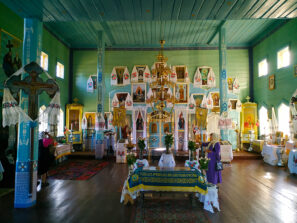Свято Успіння Пресвятої Богородиці
ГРОМАДА СЕЛА САВИН ВІТАЄ УСІХ ІЗ СВІТЛИМ СВЯТОМ – СВЯТОМ УСПІННЯ ПРЕСВЯТОЇ БОГОРОДИЦІ!
28 серпня православні та греко-католики святкують Успіння Пресвятої Богородиці або, як кажуть у народі, Першу Пречисту – одне з дванадцяти найбільших свят за церковним календарем.
Свято Успіння Пресвятої Богородиці присвячене закінченню земного життя святої Діви Марії та її безболісному переходу до життя вічного. За християнською традицією називається успінням, а не смертю. Вважається, що Свята Марія всього лише заснула, щоб через три дні прокинутися й переселитися в небесне житло.
За церковними переказами, Матері Божій під час молитви на місці вознесіння Ісуса Христа явився архангел Гавриїл та сповістив її про близьку кончину й перехід у вічність. У вказаний день апостоли, які проповідували християнство по світу, дивовижним чином зібралися в Єрусалимі біля ложа Богородиці, аби попрощатися з Дівою Марією і здійснити її поховання. Сам Спаситель в оточенні янголів зійшов до Богородиці, щоб забрати її душу із собою.
Саме у цей день завершується 14-денний піст, який стартував на Маковея.
 У святково убраному Вознесенський храмі села Савин 28 серпня було проведено урочисту службу.
У святково убраному Вознесенський храмі села Савин 28 серпня було проведено урочисту службу.
28 серпня, на свято Успіння Божої Матері, якщо він випадає на середу або п’ятницю, можна куштувати рибу. В такому випадку розговіння переноситься на наступний день. А ось якщо Успіння випадає на інші дні тижня, то посту немає. У свята Успіння є один день передсвята і 9 днів післясвята. Передсвято – один або кілька днів перед великим святом, в богослужіння якого вже входять молитви, присвячені святу яке ще наступить. Відповідно, післясвято – такі ж дні після свята. Існує особлива Служба поховання Богоматері. Її здійснюють як службу Ранньої Великої Суботи; під час неї читають 17-у кафізму – «Блаженні непорочні». В даний час Чин поховання Богоматері можна побачити в багатьох кафедральних і парафіяльних храмах на другий або третій день свята. Богослужіння починається зі всеношної. На великому хвалу духовенство храму виходить до лежачої посеред храму плащаниці із зображенням Богоматері; кадять її, а потім обносять її навколо храму. Після цього всіх, хто молився помазують єлеєм. І нарешті читаються ектенії (ряд молитовних прохань) і відпуст (благословення молільників на вихід з храму після закінчення богослужіння).
Достовірні відомості про історію свята Успіння починаються лише з кінця VI століття. Більшість церковних істориків вважають, що свято встановили при візантійському імператорі Маврикії, який правив в 592-602 роки. Він наказав святкувати його 15 серпня, бо того дня він здобув перемогу над персами. Швидше за все, до цього часу Успіння було в Константинополі помісним, тобто не загальноцерковним святом.



